Geology of Rainforest Aboriginal Stone Tools
**Caution this page may contain images of persons now deceased**Geology of Rainforest Aboriginal Stone Tools
source pers comm rainforest people Ngadjonji, Yidinji and Mamuhttp://www.jstor.org/stable/23272898?seq=#1page_scan_tab_contents
Peter E Siegel, Lithic Technology Vol 14 No2 (August 1985, pp90-94) Edge Angle As A Functional Indicator: A Test
Patrick Kooyan, Understanding Stone Tools and Archaeology Sites, University of Mexico Press 2000 pp90-94
J. Jeffrey Flenniken and J. Peter White 1985, Australian Flaked Stones, Records of Australian Museum 36 pp131-151
http://web.stanford.edu/~johnrick/precam/tools.html
R. V. S. Wright, STONE IMPLEMENTS Department of Anthropology,University of Sydney
http://www.awrana.com/index.php?value=wear-residues , Summary of Traceology
https://en.m.wikipedia.org/wiki/use-wear-analysis
Peter Hiscock, hiscockinpress.pdf, Looking the Other Way
https://www.ncbi.nlm.nih.gov/pmc/articles/PMC4773257/
http://earthsci.org/aboriginal/axehead/images/Axe_Restoration/axe_restoration.html#GEOARCHAEOLOGY
Ooyurka - T-shaped Tool
Morah Stone
Waisted Axe
Ground Edge Plain Axe
Pecked Axe / Worked Edge (flaked) Axe
Broad Axe
Pitted Rock for Nut
Cracking
Cylindrical
Grinding Stone and Hammer Rock
Re-purposed
glass fragments as pecked tools
(Tools awaiting images...under development Elongate gouges and
chisels...)
Geology of Stone Tools:
Stone
Tool Basics
Types
of Rock Used and Rock Characteristics
Structure and Function
Types
of Tools, Their Uses and Diagnostic Characteristics
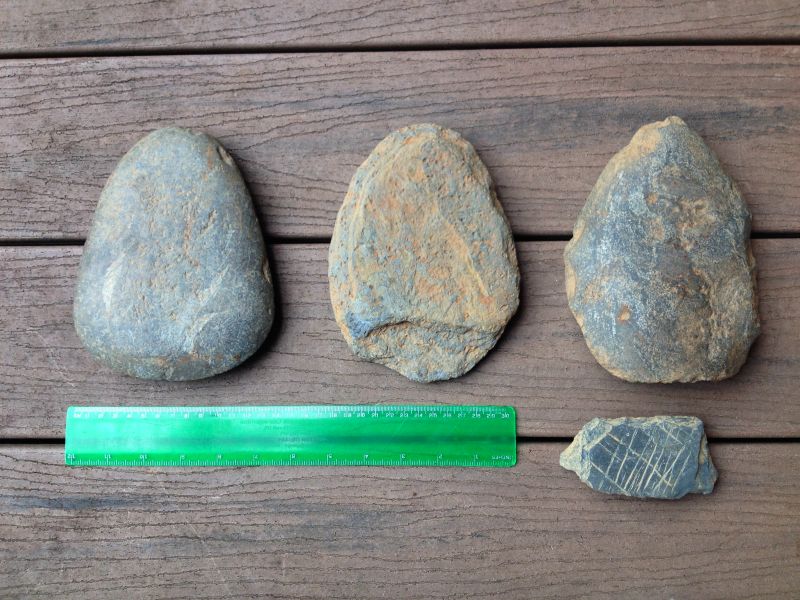
Ooyurka - unique T-shaped stone tool of the Wet Tropics Aboriginals
What is an Ooyurka?It is an Ooyurka if it is found in the far north Queensland region. It is a stone tool unique to the rainforest region. An Ooyurka needs to have some kind of shoulder waisting, the orientation of the face has to be perpendicular, and there needs to be some residue of polish, or organic material in the working face. There is a narrowness of the working face. Rocks include schist, basalt and quartzite but most are hornfels. The working face may be convex, concave or flat.
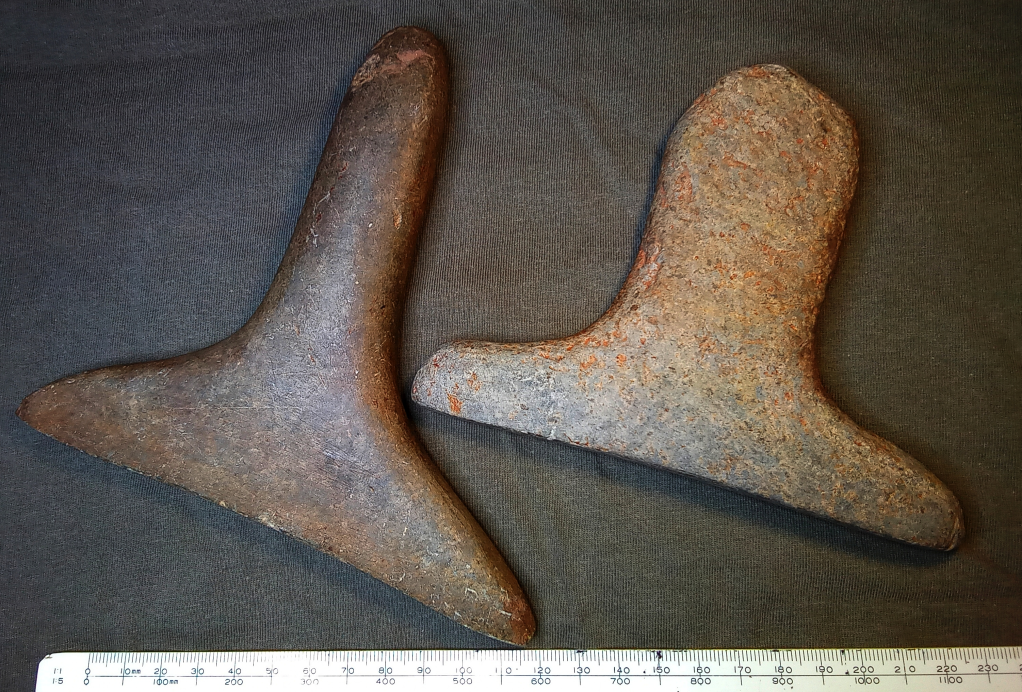
What were Ooyurkas used for?
80-90% of Ooyurkas that have been discovered have been dug up by ploughs while planting Sugar Cane. None have been radioactive carbon dated.
It is suggested that they are no older then 5,000 year old(but there is no solid evidence to support this claim), yet no one from the Dyirbal or Yidin clans know how to use the Ooyurka nor know what they are for.
Also, Ooyurka is not a word from the language of these two rainforest clans.
Kennedy in 1949 suggested the stones were used to smooth the modern Aboriginal tools such as rainforest aboriginal wooden swords.
During the wet season, the people of the rainforest were quite sedentary and would spend their time based in the one location. They built substantial large huts up to 9m long and 3m high that connected to other large huts via internal doorways.
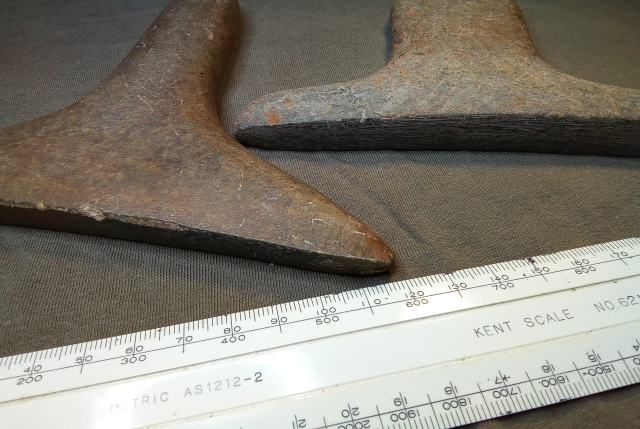
The case against them being used as "nutcrackers"
When the green cicada called they knew the bush turkey would be laying it's eggs and the mountain rainforest "nut" trees would be bearing fruit. They went to areas in the rainforest where there were nut trees, often farmed by removing unwanted saplings), harvest the nuts and storing them in the ground under "climate controlled" conditions (damp pits) until they were ready for use.
There were four kinds of nuts generally harvested (listed least toxic to most toxic)
- Black
Walnut(Endiandra palmerstonii) -->
- Hairy
Walnut ( Endiandra insignis ) -->
- Black
Bean (Castanospermum australe) -->
- Beilschmieda bancroftii (yellow walnut)
Other sources include: Kuranda quandong (Elaeocarpus bancroftii), Black Pine(Sundacarpus amarus), Macadamia whelani (macadamia nut).
It is said that the ooyurka was left behind in their shelters and used by others or used by themselves when they returned back to the area at commencement of the next wet so the tools was used primarily during the "wet season"
They became more mobile and got into hunting once the drier season started. This could entail a journey from the mountains to the coast where they built substantial , complex fish traps along the river flatlands. These fish traps needed to be re-constructed on an annual basis to to seasonal flooding.
Nuts are very hard and the working edge of the ooyurka was often less than 15mm wide and this is less than these nuts, so often the working edge would bounce/slide off the nut and hit the anvil surface, often causing damage to the (pretty soft) edge of the Ooyurka. None of the original ooyurkas showed this kind of damage.
Besides the rainforest people had excellent two piece nutcrackers. - a flat rock with incised pits or the natural pits in vesicular basalt., just the size of the nuts and a hefty hammer stone.

Geology and surface features
Ooyurkas are made from
- coarse Crystalline Basalt (only two known of this material)
- Greywacke
- Quartzite(only two known both from RussellRiver area)
- Hornfels (the most common rock used)
- (Dolerite)
- weighed between 50g and 1060g with the mean weight being 302.5g.
- majority were between 100-300gms.
- 65% had a flat working surface,
- working surface highly polished from use through movement along the long axis
- 23% concave and 12% convex.
- striations coming over the shoulders and into a V pattern at the base
- 42% show signs of initial hammer dressing
- 25% show signs of surface grinding (using a sand medium as an abrasive) particularly around the shoulders
- grinding process was used to excavate the face.in addition to the sand polishing (outcrops of sandpaper-like coarse quartzite found in the local metamorphics)
- no evidence that the ooyurka was a hinged tool and that one end of it was placed in a socket.
- lacking evidence of specific tool grinding sites where grooves show that grinding was practised for a very long time on each site.A
- all ooyurka held by the webmaster clearly fit best in the right hand only
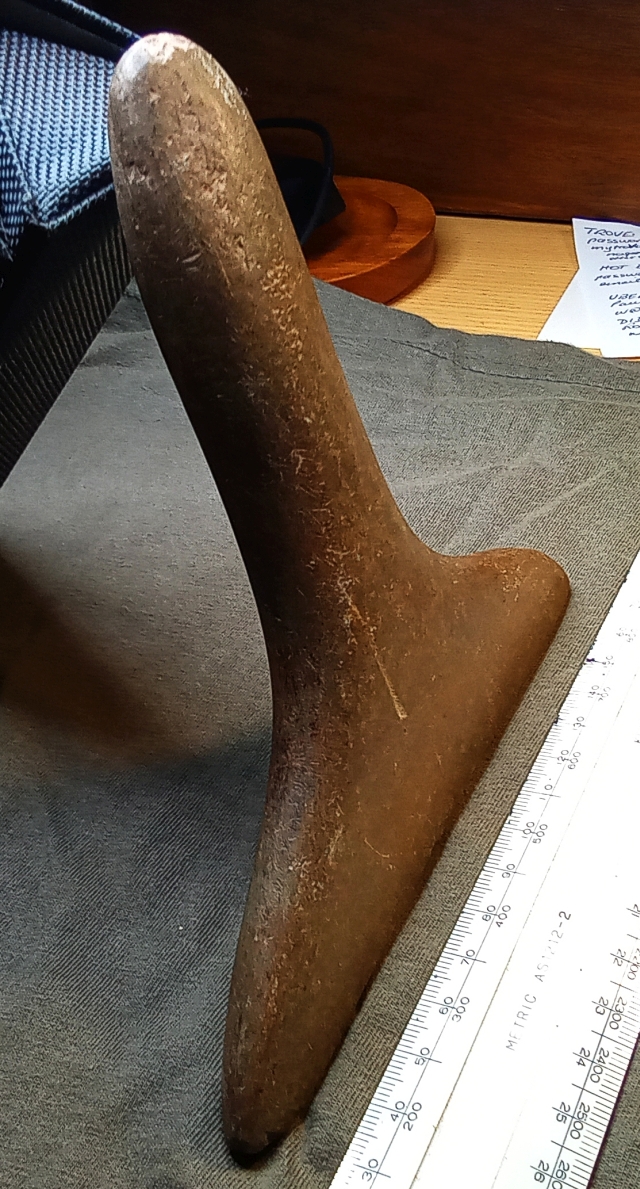
Conclusions on uses of Ooyurka
Wet season use. Most likely nothing to do with food at all. Men and women used the same tool for different purposes.
(April 2017 webmaster pers comm.with traditional owner)
Female use Ooyurka
- to strip thorns off lawyer cane stems,
- thread making bark blankets for example from the inner
bark of the Red Tulip Oak(Argyrodendron sp.) and
- rope making from lawyer cane
- very fine grinding of for example medicinal materials
- fine smoothing, shaping and polishing of the surfaces of
wooden shields, spears and boomerangs
Morah Stone
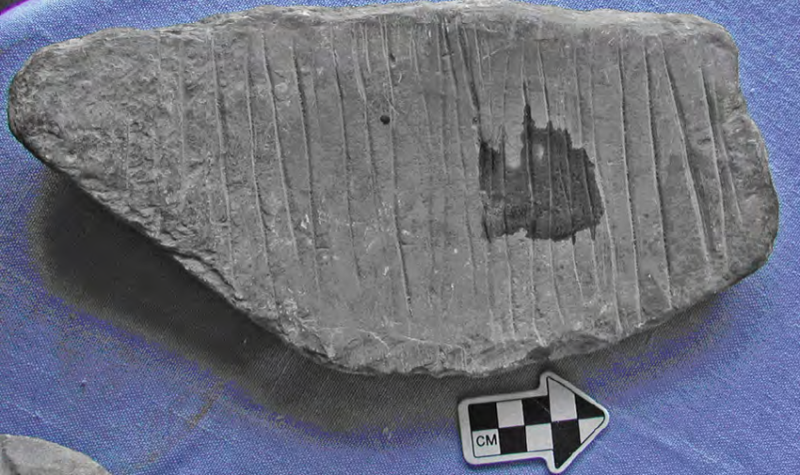
additional images: morah stone incisions detail #2 , morah Stone #3
(The following is an abridged version of a paper about starchy residues on Morah stones)
Grindstones from Australia are known to be used for a variety of functions including plant processing, preparation of ochre and also for the maceration of foods such as lizards and cats.
Grindstones are common in the tropical rainforests of far North Queensland and have often been found by farmers ploughing paddocks.
One particular type of grindstone, referred to as the morah stone, comes from a well defined area from Tully in the south, to Cairns in the north and west to the Ravenshoe area on the Atherton Tablelands.
Residue analysis has become a frequently applied method for identifying prehistoric stone tool use. Residues adhering to the stone tool with varying frequencies are interpreted as being the result of an intentional contact with the worked material during use. Yet, other processes during the life cycle of a stone tool or after deposition may leave residues and these residues may potentially lead to misinterpretations. Production, retouch, prehension, hafting, various incidental contacts during use and deposition may lead to residue depositions that significantly affect the accurateness of identifications of tool-use. Closer attention is required regarding the interaction with independent wear studies and a step-wise procedure in which a low magnification of wear traces is used as a first step for selecting potentially used flakes in archaeological contexts. In addition, residue concentrations on a tool’s edge should be sufficiently dense before linking them with use.
Morah stones (sometimes referred to as graters by locals) are made from grey slate, a soft and brittle stone that is available locally.
They are distinguished from other grindstones by a series of incised grooves running perpendicular to the axis of the artefact.
Maisie Barlow, a Jirrbal elder from Ravenshoe, relates that the incised grooves were made with quartz pieces, though bone points have also been suggested as tools for this purpose.
Webmasters personal opinion is that:
- the morah stones were the ideal surface with which to remove and collect the thin flesh of the ubiquitous and long fruiting varieties of widely available such as the quandong.
- another use is as a "plate" that is as a flat surface out of the dirt to put plant and animal foods on either pre-processing and post-processing hence this the presence of such a variety of plant and animal residues.
- no doubt they were used for grinding softer materials like fine
grinding ochres or medicinal materials but the slate just isn't
robust or thick enough for heavy duty work and no need to use a
softer imported rock when so many local robust flat surfaces are
available (basalt, granite, quaertzite, hornfels, dolerite to name
just a few)
The flat morah could also be used as a "plate" to keep crushed nuts out of the dirt - hence the starchy residue in some studies and the indications of the presence of meat. It will be interesting to see if future studies indicate the presence of haemoglobin. Why would you place meat / fish / eel in the dirt if a morah is handy? As with the Ooyurka there is no reason other than "Western thinking" to think that a stone tool requiring great labour to produce would be limited to a single purpose.
It is likely the morah would be used for other tasks such as final grinding or holding of ochres.)
Morah stones occur in a region where the processing of toxic starchy plants is common, and their use may be tied to the extended processing of these economically important foods.
Morah stones are described by an unidentified Nutjen (Ngatjin) woman to be used in a ‘rolling crushing’ motion rather than grinding. These were said to be used to crush zamia and walnuts.
The upper stones are known as ‘mugaa’.. (webmaster note: mugaa is the term in the Ngadjon language "moogi" is used in other languages)
Mugaa are usually a granite raw material, which are much harder than the slate of the morah stones. Horsfall (1987:209-211) measured over 58 morahs (22 whole and 36 fragments) and found that none of them were more than 65 mm thick, though in this study the thickness of the grindstones did not exceed 30 mm.
The thickness of the grinding stones is argued to be a function of the local slate raw material, which tends to cleave into relatively thin plates. Some of the morahs examined by Horsfall had incised grooves on both surfaces but most had incisions on only one surface. Used surfaces tend to be flat to concave, consistent with documented grindstone wear patterns.
Very few complete morahs are known and the largest morah we have observed was nearly 50 cm in length, and while broken, was mostly complete and in a private collection near Innisfail. Morahs are known from the Atherton Tablelands.
Combined with overall morphology and related use-wear studies, the function of morah stones will be discussed. Unused surfaces were smooth and featureless and not incised.
Ethnographic observations of the processing of starchy foods indicate that all surfaces of the grindstone will generally become covered in starchy material and any flaws, or incised surfaces are likely to act as residue traps.
Combined with residue studies and morphological analyses, use-wear analysis is an informative adjunct for identifying patterns of wear and probable tasks.
Of the eleven morahs that were sampled for this analysis, one grindstone yielded no starch at all, while the remainder produced variable amounts of starch. Some starch grains are very distinctive and require very few grains in order to estimate the likely species of origin - for example tubers and some grasses - however for the species likely to be represented here such as Cycas media and Beilschmieda bancroftii (yellow walnut) the overlap in size and similarities in morphology demand a larger sample for examination.
Combined with the morphology and associated use-wear patterns described below, there is compelling evidence to suggest that morah stones were used as grinding stones. On similar artefacts examined by Richard Fullagar, fine striations were found to occur at right angles to the incisions on the surface; they exhibit abrasive smoothing from grinding; and develop limited polish (polishes appear to develop on hard quartz grains within the stone matrix) - this is consistent with plant working.
It has also been noted that undertaking use-wear studies on this type of stone is problematic as the raw material is very soft and residue films obscure the surface. Nonetheless, taken together, the morphology, residues and information about use-wear on similar implements are consistent with plant processing, in this case toxic starchy plants, most probably dominated by the Yellow Walnut ( B. bancroftii ) and also Hairy Walnut ( E. insignis ).
Establishing the use of morahs for the processing of toxic starchy plants has implications for our understanding of the timing and nature of permanent settlement of rainforest environments. Long term use of rainforest environments by people may hinge on access to a suite of toxic starchy plants. The development of the technologies for processing plants such as the Black Walnut(Endiandra palmerstonii) , Yellow Walnut and Black Pine(Sundacarpus amarus) may have been transferred from the known methods for processing cycads, the antiquity of which has been reported as 13,000 years in Western Australia (Smith 1982, 1996).
Method of toxic food processing:
Cycas media is a common feature of the vegetation in the dry country on the margins of the rainforest, and the methods for processing these and the rainforest species are essentially the same – baking the starchy kernels for c. 6 hours followed by pounding to a paste, then leaching in running water for several days. The second step in this process, pounding to a paste, can also be achieved by grating with a shell (Pedley 1993).
In these studies, three separate lines of evidence are used to determine function.
- Firstly, a technological study indicating that the morphology of morahs is typical of grinding stones – they are flat, with one or both surfaces showing evidence of use. The used surface is identified by the presence of concave areas where the surface has been worn down by continuous grinding. Peculiar to morahs are the incised parallel lines that run perpendicular to the maximum length of the stones.
- Use-wear studies, the second stage in the functional analysis, indicate that these may have been made by quartz flakes as evidenced, by the sharp angular cuts and cross sectional characteristics. The raw material, slate, is a very soft stone and as such the incisions would have been relatively easy to produce. The incisions in the slate grindstones may serve the same purpose as the pecked surfaces observed on sandstone grindstones. In the latter case it is a method used to rejuvenate the grindstone surface to facilitate the breaking up of grass seed husks. The incised surfaces are always the used surfaces on the morahs.
- The residue study which was the focus of this research has shown that the incised surfaces provided ideal locations for preservation/recovery of starch. Most of the artefacts sampled produced starch grains, though in greatly varying quantities. The variations may relate to the storage conditions of the morahs which were different in each case. Nonetheless the starch recovered has provided a clear indication of target species on the basis of maximum dimension measurements. While these stones appear to have been used for the processing of Yellow Walnuts and Hairy Walnuts, it is also clear that they were used to process other toxic nuts, perhaps as they became seasonally available. It is likely that these residues represent a record of the last use of the stones.
A second species possibly identified on this stone, the Polynesian Arrowroot ( Tacca leontopetaloides ) is found on the coast in ‘open forests and extends into rainforest behind sandy beaches’ (Pedley 1993:117) and as such may act as an indicator of the location from which the stones are derived (i.e. coast as opposed to tablelands).
Conclusions
Morah stones are used in the processing of toxic starchy nuts. Comparison with modern reference materials indicates that these plants are likely to include:
- B. bancroftii (Yellow Walnut) and
- Hairy Walnut ( E. insignis ).
- Other economic species may have contributed to the residue assemblage as it appears that these artefacts are unlikely to be single use and are of a size that is easily portable.
Chemical analysis of resudues used as follows...
- Methylene Blue (C16H18N3SCI) was used to highlight non-lignified cell walls such as cellulose fibres within plant material. The stain, which is a water soluble dye, binds to the acidic pectins on the cellulose cell wall that become stained with various shades of blue
- Orange G (C16H10N2Na2O7S2)–an acidophilic dye, was used to identify animal fibres such as collagen and keratin by binding with proteins in the target material, typically staining them orange
- THemastix® testing strips indicate the presence of haemoglobin (and other iron containing materials). Tools that were presumed to be in contact with animal material (as implied by the presence of collagen fibres or the visual appearance of other tool-use residues) If colour change had not occurred after one minute, the sample was deemed negative for haemoglobin.
Waisted Axe

see how an ancient waisted axe is re-united with its lawyer cane handle, by a Yidinji elder (now deceased - used with permission), using traditional materials and methods...
A waisted axe has one doubly ground edge and a pecked or ground groove to facilitate a handle.
The waisted axe was a universal stone tool. Fitted with a lawyer can handle, it is the main tool / weapon carried by men as they traveled from place to place.
If traveling to new territory, the remaining stone tools were carried by the wives in baskets.
If traveling to an annual camp, often a set of tools would be left, easily found, amongst the large buttress roots of a rainforest giant.
The waisted axe has a medium angle ground edge so it can be re-sharpened periodically. So while the initial making of the axe was time intensive, unlike a pecked axe it could be re-furbished with a new edge.The medium edge could be used for...
- light cutting and felling
- crude cutting
- splitting
- crushing
- breaking open nuts / fruit breaking
- to quickly chip off a razor sharp flake of quartz or quartzite
- to open old logs for grubs and game
- opening holes in trees to collect honey
- dispatching snakes amongst epiphytes in the canopy
- dispatching edible wildlife
- as a weapon for informal protection (but not for formal combat)
- some waisted axes, show virtually no wear, were highly polished and made of exotic stone from distant trading - these may have been prestige items, for show (equivalent to a bloke today having an exotic sports car!)
Ground Edge Plain Axe

The majority of stone tools were ground edge axes in varying sizes with medium to blunt double ground edges.
As with all stone tools, they would be used for a multitude of purposes. Women would be the main users and the preparation of food the main area of use.This use would involve, breaking, stripping, crushing. Digging was done with a hardwood stick sharpened at one end and around 1.25 m in length.
You can tell how an axe was held by manipulating in the hand. There is only one position where holding it feels entirely comfortable.
Smaller ground axes were used in the right hand (I know of no examples of left-handed stone tools). The heavier the work the bigger and blunter the axe.
Pecked Axe / Worked Edge(flaked)Axe

Pecked axes had the sharpest edge and hence the shortest useful lifetime. They could only be re-sharpened by making the new tool considerably smaller and it probably wasn't worth the effort. Often a hastily broken of piece of quarts or quarzite could be chipped off.
Their main uses were:
- stripping thorns off vines
- splitting lawyer cane
- peeling fruit
- to skin an animal
- pecked tools to scrape skins have a distinctly curved edge
- general scraping
- to gut a fish
- to finely sharpen an object
- note:ritual cutting would entail the use of a razor sharp flake of quartz
Broad Axe
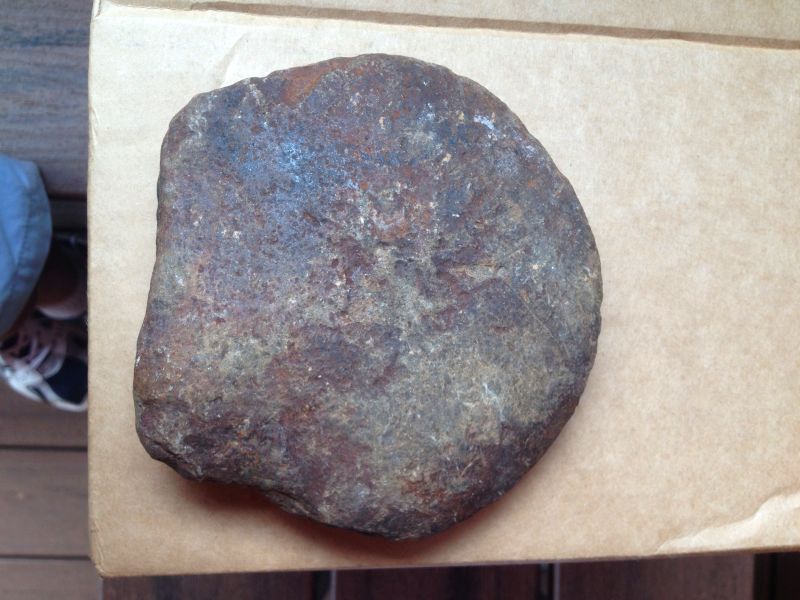
The large broadaxe may have a single or double, equal or unequal very blunt ground edges. It is used with two hands for very heavy work.The blunt edge facilitates brutal work. The tool is difficult to damage.
Uses include:
- crushing
- cutting down large objects such as trees
- heavy splitting of vines
- hammering
- as a wedge for log splitting
Pitted rock for nut cracking
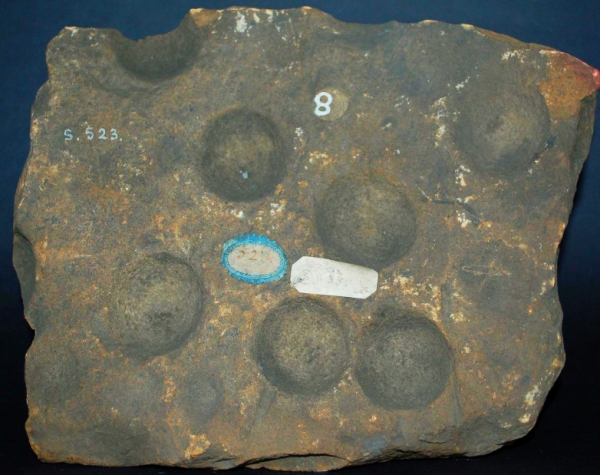
mislabelled specimen at the British Museum
A flattish piece of basalt lava with appropriately placed natural gas vesicle pits could be enhanced by further grinding out the pits to make a much prized nut cracking stone.
The rainforest provided a ready supply of nuts which were eaten by all in the "Wet Season" and by the women for a good portion of the year.
As mention previously... There were four kinds of nuts generally harvested (listed least toxic to most toxic)
- Black
Walnut(Endiandra palmerstonii) -->least toxic(90 minutes
roasting)
- Hairy
Walnut ( Endiandra insignis ) --> second most toxic
- Black
Bean (Castanospermum australe) -->third most toxic(four days of
preparation)
- Beilschmieda
bancroftii (yellow walnut) -->most toxic
Vast quantities of nuts would have been harvested and stored in damp pits (climate controlled conditions to prevent cracking)and where they could be kept intact for several months. In order to get the Black Walnut before the animals did (being the least toxic this nut was a favourite of animals and humans) , the rainforest people would climb into the canopy using lawyer cane straps in order to harvest these nuts.
Cylindrical Grinding Stone and Hammer Rock
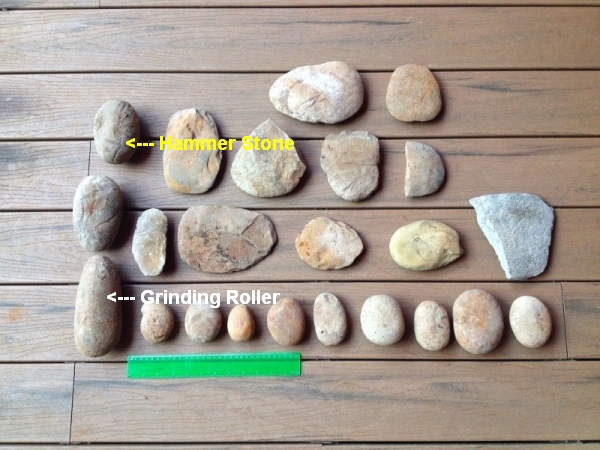
The hammer stone is used primarily for cracking nuts in the pitted nut rock shown above. The hammerstone, in larger sizes, would also be used as a hammer for driving in objects, to assist in splitting The cylindrical grinding stone could be used for a variety of grinding purposes. On the morah stone it could have been used to finely grind ochres for ceremonial purposes. On a harder platen it could have been used to grind seeds or refine the grinding of crushed nuts in the preparation of a nut based "bread".
The "Missing" Rock - Obsidian - volcanic glass?
Small patches of poor quality obsidian rock (volcanic glass) are found on the Atherton Tableland, McBride basalt province and near Chillagoe, all easily otainable by trade. Good quality obsidian should be obtainable along ancient trade routes (determined by terrain analysis) extending as far as Mount Isa.Obsidian glass can be easily chipped into razor sharp surfaces -- so why are obsidian tools missing from the suite of tool rock types ?
Re-purposed glass fragments as pecked tools
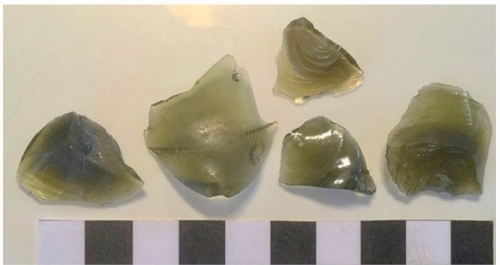
Glass tool from rum bottle Russel River circa 1885
glass tool from rum bottle Russel River circa 1885
(Tools awaiting images...under development
Elongate gouges and chisels...)
Geology of Stone Tools:
Stone Tool Basics
- One needs to avoid the Western misconception of "one tool / one
use". The same tool could be used to several tasks
for example a medium size ground edge axe could be used as a hammer, a scraper, a plane, a knife, an axe, a crusher
or
a pointed tools might function as a scraper, cutter, gouger, plant shredder ... it all depends on what is at hand at the time
in addition
the same tool may have a particular ranges of uses by men and a different range of uses by women
also
some items or objects may be gender specific or taboo for particular individuals / at particular times - The best guide on tools use is "comfort of holding". If in a certain orientation the tools fits well in the hand then that is likely the position its was held in during use.The writer has never come across a "left-handed" tool.
- Following on from "2" it is likely that in the process of hunting and gathering, an individual would come across a a piece of the right kind of rock that fit well in the hand and fashion a tool from it. The collection of suitable rocks was probably more "opportunistic" than "deliberate". The exception to the rule would be "prestige" axes as described below in "4"
- Each campsite would have the complete set of tools to match the particular food sources exploited. The existence of some exceptionally finely worked virtually unused axes using rock from distant locations (see axe#4) These exceptional axes would be carried from site to site - most show little or no wear and their purpose may have been to impress others met on route.
- The People of the Rainforest appear to have few complex "flaked" tools at best they could be described as "pecked" tools, that is some basic edge flaking.The main reason being a lack of suitable rock.
- The paucity of complex "flaked tools" is more than compensated by the sophisticated range of ground edge tools
Types of Rock Used and Rock Characteristics
Factors from western culture that need to be taken into account in order to select the right stone for a tool...- cleavage
- sharpness of fragments
- strength in2 -3 planes
- ability to "flake"
- robustness
- ability to hold a ground edge
- amenity to be re-tooled / re-sharpened/ repaired
- will "glue" for lawyer can handle adhere
Why Metamorphic Rocks?
Metamorphic rocks predominate in larger stone tools.
Metamorphic rocks are derived from pre-existing rocks that are cooked and squeezed in the solid state. These conditions, which take place without melting, cause the rock to recrystalise forming larger denser interlocking crystals. The resultant rock may have more uniform hardness and be stronger in either two or three directions depending on the rock. As a result theses rocks can be more reliably shaped and flaked that either some sedimentary rocks (too soft) or some crystalline igneous rocks (too friable). In the tropics, a region of intense weathering rock some metamorphic rocks being less permeable to water due to their higher density and interlocking crystal structure suffer less weakening.
Phyllite and slate, are associated with grinding technology and occur mainly in the form of ground and incised tools such as axe bevels and incised grinding stones.
It has been suggested that their presence in the rainforest indicates interaction and some form of trade.
Hornfels is a contact metamorphic rock formed when mudstone / shale, or other clay-rich rock, and are intruded by a hot igneous body (usually granite), and represents a heat-altered equivalent of the original rock dominantly composed of silicate + oxide minerals in varying proportions. Because pressure is not a factor in the formation of hornfels, it lacks the foliation seen in many metamorphic rocks formed under high pressure and temperature regimes. Pre-existing bedding and structure of the parent rock is generally destroyed during the formation of hornfels.
hornfels
- it is useful as raw material for stone tools as it exhibits no directional planes of weakness.
- it's horny appearance and conchoidal to subconchoidal fracture mean it will take and hold an "edge" by hammering or grinding
- as a stone tool it has a uniform hardness which means it will have uniform wear
- it is water resistant so it is not weakened by immersion nor
subject to exploding in a fire
Quartzite a metamorphic rock formed when quartz-rich sandstone or chert has been exposed to high temperatures and pressures. Such conditions fuse the quartz grains together forming a dense, hard, equigranular rock of incredible strength.
quartzite
- makes hard durable stone tools though time consuming to work with due to it's hardness
- make good "impact" tools for shaping / creating "chipped edges"
- it is useful as it displays no directional planes of weakness
- can be polished to a high degree so useful for making tools used for smoothing and polishing things like spear shafts and shields
- in an unpolished form useful for crushing and grinding tools and bases as its is less likely to impart stone grains / chips / fragments to the food as compared to for example: sandstone
- some quartzite has a conchoidal fracture so an "edge" may be made
by less labour intensive hammering but edges are not as good as
those of other rocks like hornfels and crystalline quartz
- outcrops are very likely used a site for grinding and shaping tools made of softer rocks like hornfels and greywacke - no clear permanent grinding site has been identified though logic suggests thier existence. The challenge is that many quartzite outcrops are in deep canyons, in extreme terrain within dense rainforest and have probably not been recognised for what they are.
- impact between two quartzite cobbles will produce sparks but
evidence of it's use in fire-making is lacking and sparks are a poor
alternative to the wooden bow and block method
Greywacke is a variety of indurated sandstone generally characterised by its hardness, dark color, and poorly sorted angular grains of quartz, feldspar, and small rock fragments or lithic fragments set in a compact, 15% clay-fine matrix. The hardening is caused by heat or baking near the end of the rock cycle processes of erosion, transport of eroded material by rivers, deposition onto the sea floor and then pushing up by plate tectonic movement. It remains a sedimentary rock as the heat and baking are not sufficient for the minerals to recrystallise and become a metamorphic rock, nevertheless it is hard enough to be used for ground edge axes.
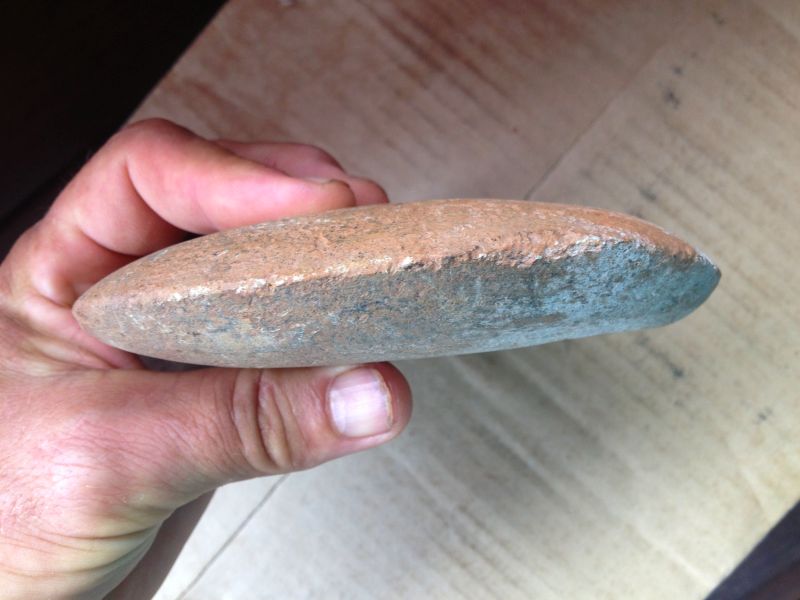
greywacke
- retains bedding planes and it's relative softness mean it will
form abundant flat shapes suitable for ground edge axes that require
a thick "wedge edge"
- softness means it can easily be "re-edged" and won't be destroyed by heavy use so it is useful for heavy duty tasks such as tree chopping
- water, scratch, stain resistant, gritty surface so it can be used
as a flat surface for shaping wood / bone or cutting, grinding
and crushing food materials or for rolling fibres out to make rope
for nets and line for fishing

slate
- most commonly used as a morah stone (often found fragmented -
destroyed after ceremonial use? or just not very robust?)
- most often incised with sub-parallel grooves to facilitate
the fine grinding of relatively soft materials for example:
ochres and medicinal materials. As a "base" using a top
"mugaa" stone made of lightly abrasive granite. Some morah
stones show rounded central wear
- possibly used to roll and remove , through the use of the
palm, the thin edible surface off abundant fruits like
quandong
- use as a "plate" - the flat surface and large surface area is
useful for keeping food items off the ground for example: cut meat
or crushed nuts thus "residue studies" may misinterpret actual it's
use use as a plate. The slate is simple too soft and too thin
(maximum thickness 65mm) to survive the forces involved in cutting
meat or slicing / crushing large hard rainforest nuts
- may be marked with symbols of unknown meaning - perhaps
spiritual / "men or womens business", maybe a map or message
Tools may also made from fine grained igneous rocks such as dolerite, rhyolite and basalt (sometimes metamorphosed basalt)
Crystalline quartz , due to chonchoidal fracture resulting in very sharp edges are available throughout the rainforest area. "Milky" "bull" quartz though not as sharp as crystalline quartz is ubiquitious and can be fractured to form useful sharp fragments.
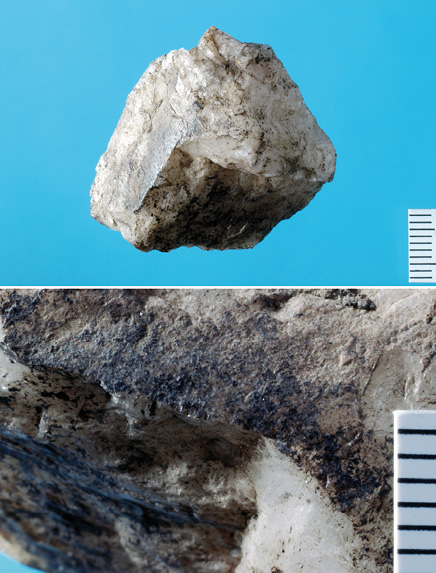
"bull" quartz (opaque) - core from which flakes have been removed
Chert is a micro-crystalline sedimentary rock found at some distance inthe Chillagoe area that creates when fractured or flaked very sharp chonchoidal edges, while chert is present , probably due to trade, rainforest crystalline quartz appears more commonly used as it is local. Evidence of local trading. On the Atherton Tablelands there is likely a small local patch of poor quallity obsidian evidenced from a few sharp fragments scattered in the rainforest that may or may not be tools.
Crystalline Quartz and "Bull" Quartz - the majority of small "artefacts" (small sharp fragments and flakes) are made of quartz. It is extremely difficult to establish whether edge modifications represent deliberate retouch or use-wear damage, especially on the edges of inferred ‘scraping implements’. The raw materials are easy to find and sharp edges are easy to make, so much so that it is probably easier to create a new "artefact" that to retouch an old one. Quartz artefacts are found scattered everywhere in the rainforest as if when hunting / gathering they are taken along as a sort of "pocket knife" and readily discarded when carrying them is no longer convenient.
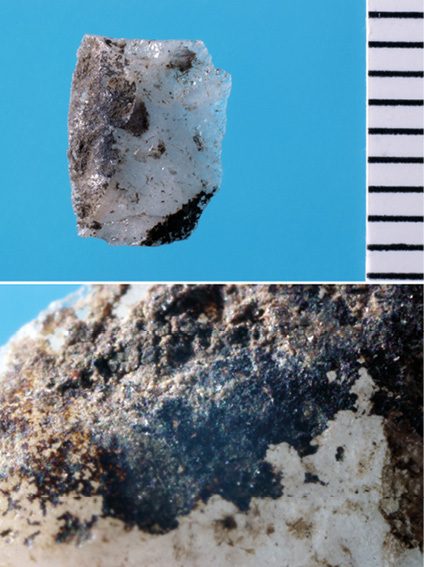
"crystalline" quartz(semi-transparent - makes sharper flakes
- easily found and easily chipped to a sharp edge ... quartz
fragments are scattered throughout the rainforest and act as "pocket
knives" . It is difficult to say which fragments are natural and
which deliberate unless there is evidence of a clear hammer impact
event
dolerite
- the very fine grains make this rock strong in all planes
- not amenable to "chipping" only useful as a ground edge tool
- it can be ground to a smooth fine edge and an example traded from
the Kalkadoon people in the Mount Isa region 1200km away
appears to be a "prestige item". While dolerite is found locally
within the rainforest it does not appear to have been chosen for
tools - preference seems to be for imported material reasons unknown.(see Axe #4)
- tools made from this material would be very time consuming to
produce as starting from angular equidimensional source material the
axe would have to be entirely ground to it's final flatish shape
- the relatively sharp edge means the tool would be used to chop or cut softer materials (this may initially appear counter intuitive but thick durable "wedge edges" are better able to with stand the immense forces of chopping harder materials and keener / sharper edges are only up to the task of chopping softer materials)
- when wet it loses about 1/3rd of its strength
Massive basalt from flows.
Vesicular basalt - porous with natural "vesicles" and pits(from gas expansion).
Columnar basalt formed by hexagonal shrinkage cracking in slow cooling ash buried lava flows
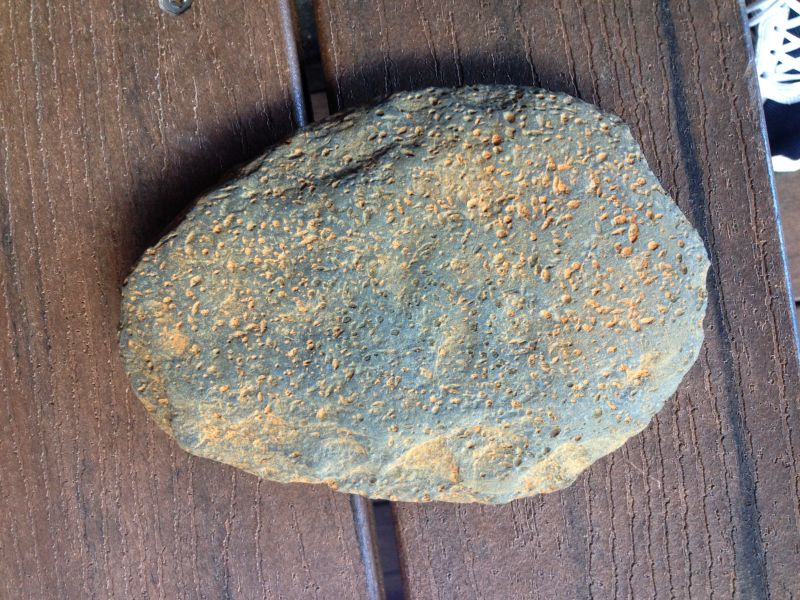
basalt
- some ookurya are made from what appears to be a unique source
of a particular coarse crystalline basalt, the quarry location
unknown, however, massive basalt in general is not
particularly useful in tool making other than for crushing things
like nuts and making lawyer vine into fibre. The flow-bands create
difficult to see zones of weakness so the rock is tricky to shape or
sharpen but it will retain heat so is handy for pit ovens.
- vesicular basalt creates tools in it's natural form as rounded cobbles or boulders. The material is ubiquitous in the local region. Large pits are ideal to; hold large rainforest nuts while they are cracked and open - the pits are ubiquitous in the local volcanic region. Elsewhere sandstone is used and uniform pits are ground out using a larger version of a fire bow , water and sand. Fine vesicles as found in locally available scoria could make ideal sandpaper or wood shaping tools but there is no clear evidence of their use
- columnar basalt forms hexgonal shaped columns up to about a half metre across that split horizontally to form flat hexagonal surfaces that may be useful near the source but are too bulky to carry any distance. There is no clear evidence of their use.
It is fairly easy to cleave a block into flattened layers. Stone tools made of gneiss appear rudimentary and show significant wear
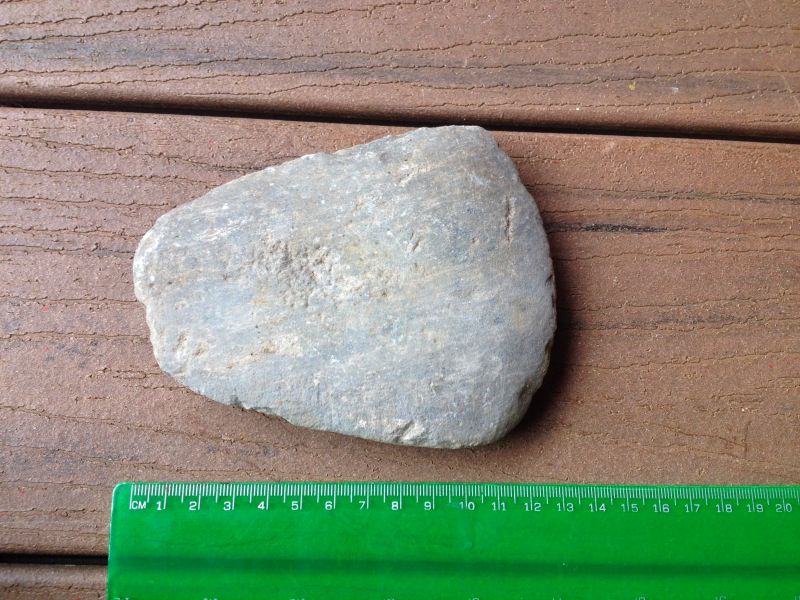
gneiss
Imports: Rhyolite and fine-grained raw materials
Rhyolite, chert, and other fine-grained raw materials were possibly transported to the site from drier areas with different geology located to the west of the rainforest region, where these raw materials are available . No known local outcrops or exposures of rhyolite are found. The closest known source is in the drier sclerophyll area located to the west of the Evelyn Tableland. Few rhyolite tools are found. In the tools found the stone material appears to be retained and reused but perhaps because of it's hardness, hence difficulty to work, rhyolite may just have been and unpopular material. Both options may be a result of the distance rhyolite had to be transported. It is possible that quartz was not only locally available but also the raw material favoured for use in stone working by Aboriginal rainforest people.
Structure and Function
Types of Tools, Their Uses and Diagnostic Characteristics
Some edge angles of Australian stone tools as a very rough guide to their possible use...- Food Scrapers - heavy duty - 60-90°generally rounded, 2 equal edges
- Hide Scrapers -high edge angle, 2 equal "distinctly curved" edges
- Chopping - heavy duty - 66-75° mean71° generally, more oval, 2 equal blunt edges
- Adzes -heavy duty - 50-70°mean 60°-elongate oval, 1-2 unequal edges usually ground
- Cutting - 23-30° -various shapes,1 edge
- Saw -46-55° -most frequent 50°
- Gouges-"U"shaped groove
- Chisels -narrow adze
- Nut Crackers -pits
- Ooyurka -"T" shaped
- Morah stones - flat sub-parallel grooved surface
- Grinder -cylindrical +/- tapered ends or semi-cylindrical with one "flat" side
- Wooden and bone tools
- Glass tools -repurposed bottle fragments with pecked edges

